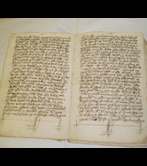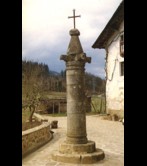The villas’ internal regime
During the first centuries after they were founded, the institutional organization of the majority of the villas in Gipuzkoa followed the same basic pattern of town councils made up of mayors, judges and, gradually, local representatives. Membership was increasingly made up of representatives of the wealthiest families who formed local political elites and who put their stamp on the history and character of the villas. Despite the relative homogeneity, each villa has its own characteristics and differing numbers of officials (one or two mayors) and some also bore different titles (senior judges, registrars, registrar-representatives, etc.) and sometimes included other officials such as the provost, who was the royal representative.
A large number of council ordinances were also drawn up covering various aspects of daily life: hygiene and health; the supply of basic goods and other aspects of economic life such as fishing, trade, tree planting and urban development, with building and fire prevention regulations; by laws covering such activities as begging, play, aggression, robbery and, of course, policies related to the electoral system and the naming of council officials. These texts are fundamental to understanding the society of the day.
The policies regarding the supply of goods emphasized the importance of guaranteeing the supply of basic foodstuffs such as cereals, as well as avoiding fraud in prices and weights and measures and the need for consumer protection. They also specified where butchers shops and fishmongers could be located, and specifically where they were located in Deba, Segura, Tolosa and Zestoa. They also sought to avoid fraud involving wine and cider. For example, since the 14th century Tolosa had been selling watered-down cider as though it were the real thing. Harmful practices were banned. Fishing nets were regulated and in Legazpia in 1533, dumping lime into the rivers was banned. At the same time there were numerous debates about forest management, in which there were conflicting interests between livestock farmers, charcoal makers, the shipyards, carpenters and the iron works. Regulations concerning tree-planting took up a number of chapters as demand for wood in the construction of buildings and ships grew.
Other ordinances regulated public order, hygiene and public health. Insulting and aggressive behaviour was punished to varying degrees, depending on the seriousness of the offence, such as whether the cuts had bled to or not, or the effects of the injury etc. Gambling (with dice) and robbery were also punished. Given that this was a highly religious society, it is not surprising that there were punishments for blaspheming and also for excessive weeping or displays of emotion at funerals. This last ruling may have been an effort to prevent the use of mourners at funerals as a way of displaying prestige and wealth, as well as prohibiting ostentatious and clothing and hairstyles, as was established, among other places, in the ordinances of Deba in 1412.
These measures give us an idea of the ideals of peaceful coexistence at a time, based on a Christian spirit and an established social order.




